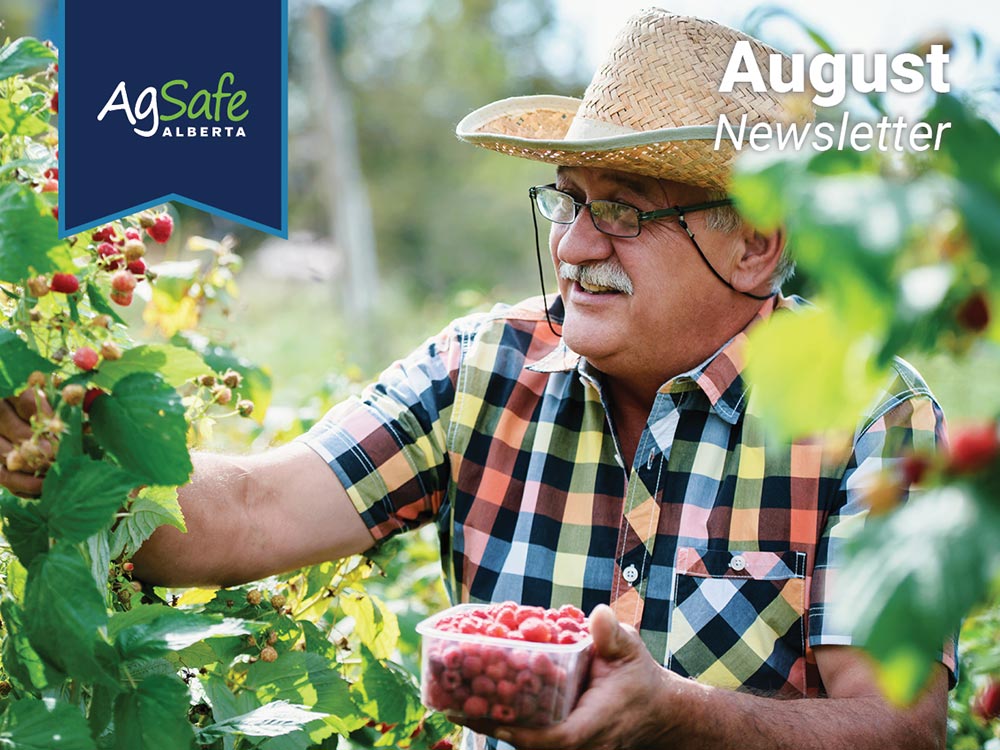
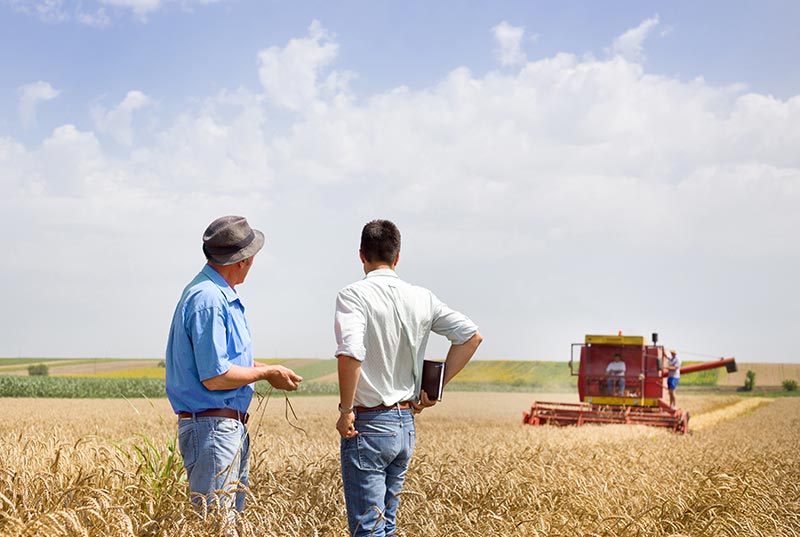
Are Your Contractors Really Contractors?
When you hire someone as a contractor, it is important to ensure that they really are a contractor. Even if the person hired is truly a contractor, the farm will still have health and safety responsibilities regarding the contractor and their workers (these responsibilities are detailed in Part 1 General Obligations of the Alberta OHS Act).
Deciding whether someone is a worker or a contractor comes down to many factors. Below is a table with some of these factors that you can use to help determine if the person you have hired is truly a contractor or if they are an employee.
| Employee | Contractor | |
| Do they operate a business? | No. | Yes. Business owners should have:
|
| Who sets the hours of work? | The employer. Commonly works regular or set hours as directed. | The contractor. Generally, they set their own schedule. |
| How do they get paid? | Receives:
| Submits invoices. Payment reflects the terms of the contract, such as the full amount upon completion of the work or installments. |
| Does the person doing the work receive training from the person paying them? | Yes, this can include:
| No. A contractor will come to work already having the necessary training and will have paid for their own training. |
| Who directs the work activities (e.g., what tasks to do in what order)? | Their employer. | A contractor works independently and is self-directed. |
| Does the person advertise their services? | No. | Yes. |
| Does the person have other clients and work other jobs? | No, though some people may work for more than one employer (e.g., two part-time jobs). | Yes. Most contractors will have several other clients and jobs. |
| Does the person provide quotes or estimates for the work to be done? | No. | Yes. |
| Who supplies the tools and equipment to perform the work? | The employer. | A contractor provides these. |
| How closely are their duties connected to the purpose of the business or farming operation? | Very closely; they are a part of the farm’s regular operations. | Not very closely; for example, they are contracted to perform a specific job one time or maybe once a year to do the same thing (e.g., custom harvest crew). |
| Is there a contract or other written agreement where they agree to be a contractor and take on the work? | No. Employment agreements will state the person is an employee. | Yes. The contract will state that they agree to being a contractor and to taking on the work. |
To learn more, check out this webinar with Christopher Spasoff, OHS Lawyer and founder of F2 Legal Counsel: Contracting Ag Services in the Age of Tractors, Contractors, and Tik-Tok.

If you have farm-specific health and safety questions or require support relating to health and safety on your farm, please contact AgSafe Alberta at info@agsafeab.ca.
You may be eligible for onsite farm visits and up to 10 hours of advisor support at no cost!
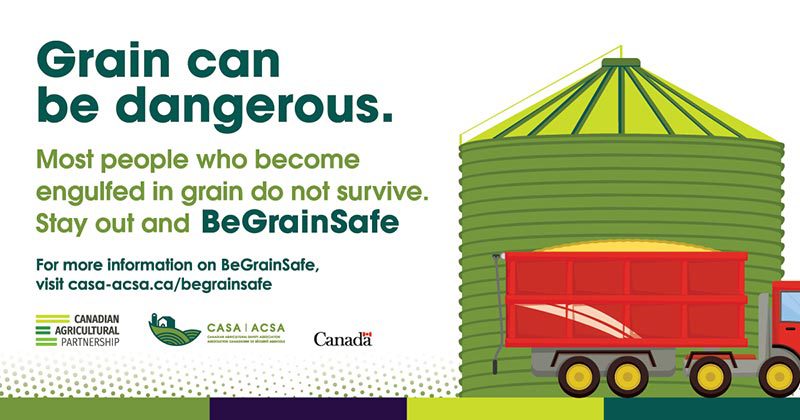
BeGrainSafe Week 2025
BeGrainSafe Week (August 11-17, 2025) is an initiative of the Canadian Agricultural Safety Association (CASA) that raises awareness about the dangers associated with grain. While grain entrapments typically come to mind, there are, in reality, many hazards associated with grain handling, storage, harvesting and other related activities.
For more information on BeGrainSafe Week and grain safety, visit the CASA website and check out these videos:
Following Proper Grain Bin Entry Procedures Saves Lives – US Agricultural Safety and Health Centers
Grain Bin Entrapment: Seconds to Tragedy – Grain Handling Safety Coalition
Grain Bin Safety – Lock Out/Tag Out, Each Time, Every Time – National Farm Medicine Centre
The BeGrainSafe Trailer will be in Picture Butte on August 9, in the County of Newell from August 22-24 and in Wheatland County on September 6. For more information, contact CASA directly at (877) 452-2272 or email info@casa-acsa.ca.
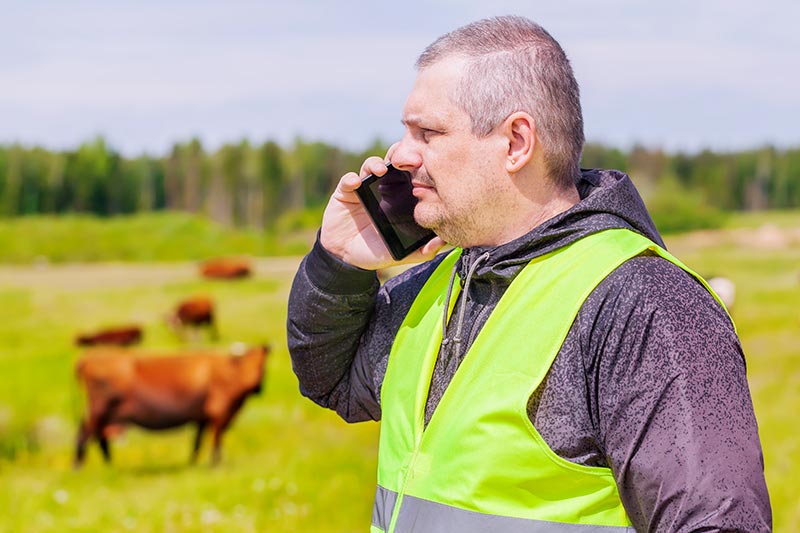
Working Alone Reminders
Someone is considered to be working alone when they cannot be seen or heard by someone else and assistance is not readily available to the worker should there be an injury, illness or other emergency. Working alone is a common occurrence in agriculture and presents a risk that needs to be managed. Consider the following points before someone works alone on your farm:
- Should the person be working alone at all? Think about what could go wrong and how bad the outcome could be (i.e., identify the existing and potential hazards, then assess them for risk; you can refer to the AgSafe Alberta FarmSafe Plan Manual for help with this).
- Does the person have the training, experience, skill and ability to work safely without supervision? Is anyone else nearby?
- Is the person reasonably healthy and fit? Do they have an injury or illness that could impact their ability to work alone safely? Are they taking any medications that may affect their thinking, motor skills or how extreme temperatures may affect them?
- Is this person a new, older or young worker? Remember, new, older and young workers have unique work factors that will affect their ability to work safely.
- What is a reasonable length of time for the person to be working alone for and how long will or could the job take? How often will someone need to check in on them? Will the check-in be done visually or verbally?
- What time of day will the person be working alone, (e.g., early in the morning, late at night, in the dark or during the hottest time of the day)?
- Is it reasonable for the person to be alone? No one should be working alone in a confined space (e.g., septic tank) or on machines that need to be locked out and tagged out.
- Is there a tested form of communication in place that will work as needed in all situations?
- If the communication system is in a vehicle or piece of equipment, is another form of communication needed when the person is outside the vehicle or equipment (e.g., performing repairs on the equipment)?
- Does the work area, vehicle or equipment have the necessary emergency supplies, such as food, water, a first aid kit and a fire extinguisher? Is the person working alone trained to use the first aid equipment available to them?
- How far away from someone else is the person working alone? Is it a few yards in a building or is it several kilometres?
- If someone needs to get to that location and help the person who has been working alone, is there a form of transportation available that will allow the person to be brought back if needed? Is the check person trained in first aid?
- Does the farm have emergency action plans that can be followed in the event of an emergency? Is there a transportation plan in place and ready to use should a person who has been working alone require transport to the nearest hospital?
You can share this information with your farm team by downloading and printing the AgSafe Alberta Toolbox Talk Important Factors to Consider When Working Alone.
Create a working alone plan today using this sample template: Working Alone Plan Sample 01.
If you missed it last month, you can also use AgSafe Alberta’s Worksite Emergency Transportation Plan.
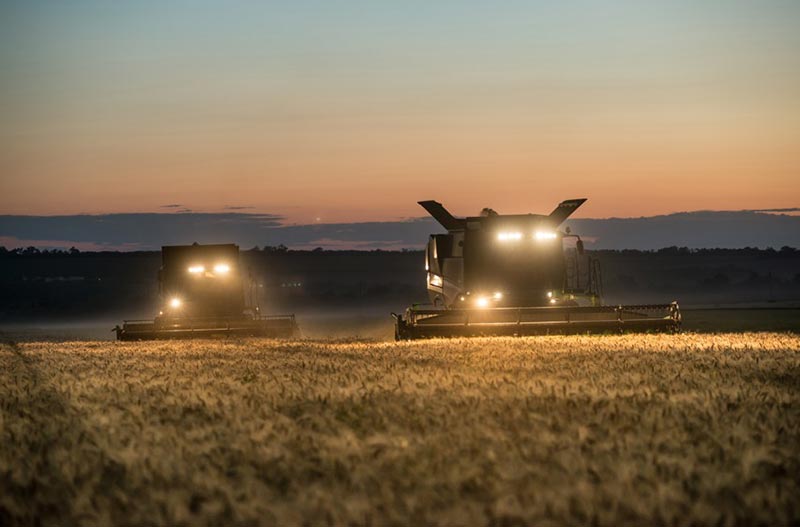
Fatigue is a State of Impairment
At this time of year, many of us are putting in some very long, hard workdays while operating extremely large, noisy and potentially dangerous equipment. In other industries, this type of work would be considered safety sensitive – where an incident could result in serious injury to the person performing it or someone else.
We need to recognize that fatigue is a state of impairment. It reduces your alertness, concentration and reaction time and is a common yet unrecognized hazard on farms and ranches. Like all hazards, once you recognize them, you can assess them and take steps to minimize the risk.
Take a few moments to check out the links below and think about how your operation can better manage fatigue:
Watch Waking Up to Fatigue Factors on the Farm, a webinar presented by Kimberly Hobbs of In-Scope Solutions as part of our 2022 Growing Farm Safety Webinar Series.
Fatigue, Extended Work Hours and Workplace Safety Bulletin by the Alberta Government
Find fatigue information and tools available from the National Safety Council
CONTACT US
